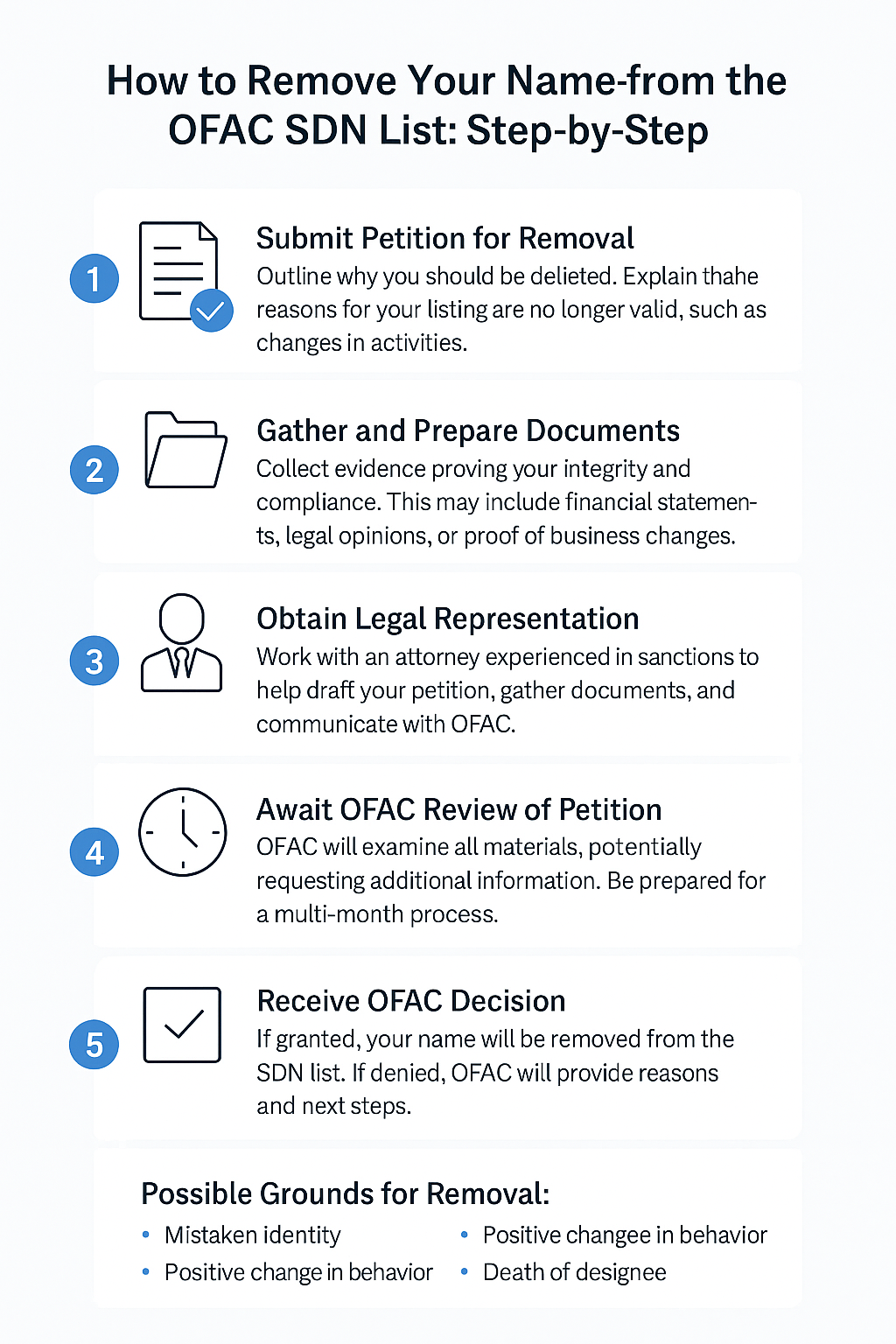
How Do Get Off the SDN List?
If your bank account has been frozen or your company is facing sudden transaction rejections, there’s a high chance your name is on the OFAC SDN list. But is it possible to get off that list?
In the context of modern international financial regulation, sanction lists play a key role in ensuring compliance with legal norms and regulating foreign economic activity. One such list is the Specially Designated Nationals List (SDN), which is maintained by the Office of Foreign Assets Control (OFAC) of the U.S. Department of the Treasury.
Being added to the SDN list can have serious consequences for business entities, financial institutions, and individuals. Let’s take a look at the process for getting removed from the SDN list, or the procedures governing delisting, common mistakes that lead to being included on it, and the difference between OFAC administrative subpoenas and being placed on the SDN list.

What is the OFAC SDN list?
The OFAC SDN List is a roster of individuals and entities with whom U.S. citizens and organizations are prohibited from doing business. It’s compiled by OFAC, a division of the U.S. Department of the Treasury responsible for enforcing sanctions. Inclusion on this list can occur for various reasons, from accusations of sanction violations to identification errors. However, the outcome is almost always the same: asset freezes, restrictions on banking operations, and significant reputational risks.
Under us sanctions law, an entity becomes an SDN if it is owned by an SDN by what proportion?
It’s important to note that, under U.S. sanctions law, an entity automatically becomes an SDN (meaning its assets are blocked) if it is 50 percent or more owned by one or more persons already included on the SDN list (blocked persons). This means that even if a company isn’t explicitly named on the SDN list, it still falls under the same restrictions if someone on the list controls or owns it in the specified proportion. This rule applies to both direct and indirect ownership and is key to preventing the circumvention of sanctions through complex ownership structures.
Can a Name Be Removed from the SDN List?
Yes, it’s a very real, though not quick, process. To achieve delisting, you need to prove that the grounds for inclusion no longer exist. For example, the individual has ceased the activities that led to their listing, or they were included by mistake. This involves preparing a written statement with arguments and evidence, then submitting it to OFAC. It’s best to do this with the help of a lawyer who knows how to build a proper strategy and avoid rejection. Successful removal from the SDN list is possible if everything is prepared correctly and there are no new violations.
Are You Eligible to Request Removal from the SDN List?
Before submitting a formal petition to OFAC, ask yourself the following questions:
- Could you have been added to the list by mistake (for example, due to a name match)?
- Have you stopped the activity that led to your designation?
- Has it been more than 12 months since the last potential sanctions-related incident?
- Are you no longer affiliated with any sanctioned individuals, entities, or governments?
*If you answered “yes” to one or more of these questions, you may be eligible to file a request for removal from the OFAC SDN list.
What is the procedure for removing a name from the SDN list?
Removing a listed person from the OFAC SDN list is a multi-step process requiring specific procedures and rules. Let’s go over the key steps you need to take to request to remove and delete your SDN from the OFAC sanctions list.
To successfully request to get off the OFAC sanctions list, do the following as discussed in greater detail below:
- Applying for an Exemption: The first step is to submit an official application to remove SDN from OFAC. In your application, you need to list all the reasons why you believe your name should be removed from the list. It’s crucial to provide compelling evidence that the reasons for your inclusion on the list no longer exist. This could include changes in your activities, financial statements, legal opinions, and other documents;
- Gathering and preparing documentation: The need to provide detailed documents cannot be underestimated. It’s crucial to collect all relevant documents that can verify your integrity and compliance with all regulations. This may include financial statements, evidence of adherence to sanctions regulations, and documents confirming changes in business practices;
- Legal Representation: It’s recommended to seek assistance from an attorney who specializes in sanctions compliance and OFAC regulations. A qualified lawyer can help properly prepare your application, gather the necessary documents, and effectively communicate with OFAC. This can help avoid mistakes that might delay the process or lead to a denial;
- Application Review Process: OFAC will review your application and conduct a thorough investigation of the submitted data. The review process can take a significant amount of time, as it’s essential to carefully analyze all the materials provided. It’s important to be prepared for potential additional requests from OFAC and to promptly provide any requested information;
- Getting a Decision from OFAC: Once your application has been reviewed, OFAC will decide on whether you can be removed from the SDN list. If the decision is in your favor, your name will be taken off the list. Otherwise, OFAC will explain the denial and suggestions on how to address the issue.
The SDN list removal request may also include information, such as arguments or evidence that establishes that an insufficient basis exists for the listing or to demonstrate that the circumstances resulting in the listing designation no longer apply. It should be possible to identify all applicable grounds for a request seeking removal from the SDN list. As identified by OFAC, these grounds may include: Mistaken identity; A “positive change in behavior;” The death of an SDN; or, The basis for the designation no longer exists.

What common mistakes lead to someone being added to the SDN list?
The Specially Designated Nationals (SDN) list, established by the U.S. Office of Foreign Assets Control (OFAC), includes individuals and organizations whose activities may threaten national security or international stability. Reasons for persons being added to this list often relate to violations of U.S. sanctions. The main mistakes leading to the inclusion of persons in the SDN are as follows:
- Violating sanction requirements: A common reason for being added to the OFAC SDN list is engaging in transactions with individuals or organizations that are already under sanctions, or failing to comply with OFAC license conditions. It’s crucial to closely monitor current requirements and avoid any violations;
- Errors in financial reporting: Incorrect presentation of financial statements or false information in documents can lead to being placed on the OFAC SDN list. Complete and accurate reporting is critically important for complying with OFAC requirements. The presence of errors or incomplete data can raise suspicions and lead to sanctions;
- Involvement in Illegal Activities: Participating in activities that violate U.S. laws or international sanctions can lead to being added to the SDN (Specially Designated Nationals) list. This could include financing terrorism, trading in prohibited goods, or engaging in corruption. It’s crucial to thoroughly vet your business partners and steer clear of questionable transactions;
- Identification Errors: Sometimes being added to the OFAC SDN list happens due to identification errors. This can be due to mistakes in matching data or similarities in names. In such cases, it’s important to promptly correct the errors and provide evidence for removal from the list.
Is receiving an OFAC administrative subpoena equivalent to being placed on the SDN list?
The OFAC administrative subpoena, being the subject and placed on the designated SDN designation list, are two separate legal mechanisms related to enforcing sanctions compliance, but they differ in their legal nature and consequences. An administrative subpoena issued by OFAC is an official notice of a suspected sanctions violation, which can serve as both a preliminary warning about potential violations and a request for additional information as part of an investigation.
Receiving an administrative subpoena does not automatically result in being placed on the SDN designation list; it acts as a cautionary or informational measure, for example, giving the entity a chance to address or clarify any issues before more severe sanctions measures are applied.
Being added to the OFAC SDN list is a more serious legal action that imposes specific financial services restrictions. Individuals and organizations on this list face a ban on conducting financial services and transactions with U.S. citizens and other services to American companies. This significantly limits their business opportunities with financial services and financial services and institutions and can have long-term consequences.
Getting removed from the SDN list is a complex process that requires careful attention and adherence to all necessary procedures. Understanding the reasons for being placed on the list and seeking help from professional lawyers can significantly aid in successfully petitioning and reconsideration process for getting delisted.
To request removal of an OFAC administrative subpoena and petitioning for an SDN list removal have their unique aspects, and it’s important not to confuse them. Each process holds its significance in the context of complying with all OFAC’s sanctions programs and requirements.
Contact our OFAC lawyers
Consulting our attorneys who specialize in OFAC-related matters ensures expert assistance in resolving complex issues tied to sanctions. Our lawyers will help you prepare, file, and submit all necessary documents, file, respond to, and address challenges with frozen assets and persons. By working with our specialists, you can be confident that all matters will be handled in full compliance with the current OFAC requirements.
FAQs
How long does the process of removal from the SDN list take?
Each year, OFAC removes hundreds of individuals, financial institutions, and entities from the SDN list. Each removal is based on a thorough and rigorous review process by OFAC.” As there are tens of thousands of companies, financial institutions, and individuals on the SDN list, this makes it clear that getting a listed person removed from the list is a rigorous and thorough review process.
The process of sanctions programs for SDN and blocked persons list removal can take several months or years, depending on the circumstances of the OFAC application. That results in the complexity of the OFAC interview of the case and the evidence provided. In some instances, it may take even longer to apply sometimes anywhere from 6 months to a year.
It is essential to ensure that all documents, including a detailed description of why the listed person should be removed from the blocked persons’ list, are accurately prepared and meet OFAC’s requirements. Incomplete documentation often may cause delays.
Similarly, any false or misleading information provided may result in the delay and or denial of the final determination by ofac hearing your case. Additionally, it is important to consider that the government’s decision depends on various factors, including the political and other circumstances resulting in the legal context that ofac applies during the ofac hearing.
Can I travel internationally if I’m on the OFAC SDN list?
Being listed on the OFAC Specially Designated Nationals (SDN) list does not automatically prohibit you from traveling internationally. However, many countries and airlines may restrict your travel due to U.S. sanctions. You might face visa denials, entry refusals at borders, or increased scrutiny. Additionally, accessing international financial services while traveling may be limited. Overall, international travel can be difficult and risky if you are on the SDN list.
Does delisting unfreeze my assets?
If you are removed (delisted) from the SDN list, the assets that were frozen due to sanctions are generally unfrozen. This means you regain access to your blocked accounts, funds, and property. However, the unfreezing process may take some time, as banks and financial institutions need to confirm the update and complete internal compliance procedures.
Who do blocked funds from individuals on the SDN list belong to?
Blocked funds belonging to individuals on the SDN list remain the property of those individuals in legal terms. However, access and control over these assets are restricted-no one may use or transfer the funds without explicit authorization from OFAC. The sanctions aim to prevent these assets from being used for prohibited activities. In some cases, blocked funds may be subject to confiscation or transferred to government funds if the sanctions authorize such actions.




